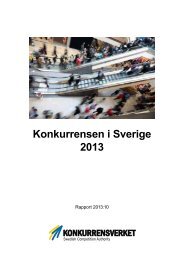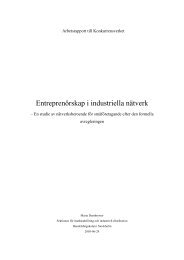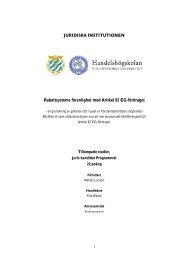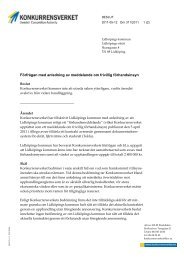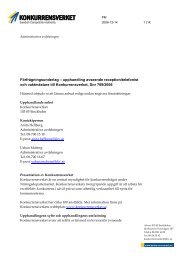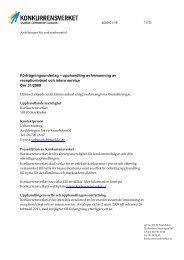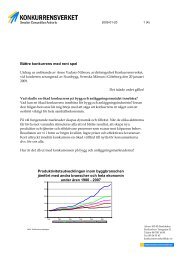Report 1996:3, Deregulation of the Swedish Electricity Market
Report 1996:3, Deregulation of the Swedish Electricity Market
Report 1996:3, Deregulation of the Swedish Electricity Market
Create successful ePaper yourself
Turn your PDF publications into a flip-book with our unique Google optimized e-Paper software.
SWEDISH COMPETITION AUTHORITY<br />
<strong>Deregulation</strong> <strong>of</strong> <strong>the</strong> <strong>Swedish</strong> <strong>Electricity</strong> <strong>Market</strong>
<strong>Swedish</strong> Competition Authority<br />
November <strong>1996</strong><br />
ISSN 1401-8438<br />
Tryckgruppen AB, Stockholm <strong>1996</strong>
Contents:<br />
1 Rules for <strong>the</strong> <strong>Swedish</strong> electricity market 6<br />
2 Background 8<br />
2.1 Following-up <strong>the</strong> electricity market 8<br />
2.2 Deregulated markets - earlier experiences 8<br />
3 <strong>Market</strong> structure 10<br />
3.1 <strong>Electricity</strong> generation and generating companies 10<br />
3.2 <strong>Electricity</strong> distribution - sales and transmission <strong>of</strong><br />
electricity 11<br />
4 <strong>Market</strong> development and competition conditions 13<br />
4.1 Generating companies and foreign trade 14<br />
4.2 <strong>Electricity</strong> distribution - sales and transmission<br />
companies 16<br />
4.3 Competition between different systems for residential<br />
heating 20<br />
5 Conclusions and summary <strong>of</strong> proposals 21
1 Rules for <strong>the</strong> <strong>Swedish</strong> electricity market<br />
The <strong>Swedish</strong> Parliament decided in October 1995 to introduce new legislation<br />
in Sweden for <strong>the</strong> electricity market to take effect as <strong>of</strong> 1st January<br />
<strong>1996</strong>. These regulations introduce competition on <strong>the</strong> electricity market in<br />
<strong>the</strong> generation and distribution <strong>of</strong> electricity. The aim is to provide<br />
consumers with greater freedom <strong>of</strong> choice and better opportunities for<br />
putting pressure on costs and prices in <strong>the</strong> supply <strong>of</strong> electricity. Transmission,<br />
and access to <strong>the</strong> networks will remain a monopoly and will be run<br />
in a special company separate from <strong>the</strong> distribution <strong>of</strong> electricity. Transmission<br />
will be subject to separate accounting procedures. When charging<br />
customers, <strong>the</strong> total cost <strong>of</strong> electricity should be separated into two components,<br />
<strong>the</strong> transmission price and <strong>the</strong> price <strong>of</strong> <strong>the</strong> electricity.<br />
A new authority, <strong>the</strong> <strong>Electricity</strong> Network Authority has <strong>the</strong> task <strong>of</strong> determining<br />
whe<strong>the</strong>r transmission prices reflect efficient use <strong>of</strong> <strong>the</strong> national<br />
grid and <strong>the</strong> regional and local networks. Decisions <strong>of</strong> <strong>the</strong> Regulatory<br />
Authority may be appealed to <strong>the</strong> general administrative court. One <strong>of</strong> <strong>the</strong><br />
aims <strong>of</strong> regulating transmission is to create better opportunities for identifying<br />
and preventing economic surplus from arising as a result <strong>of</strong> excessive<br />
transmission prices, which might <strong>the</strong>n be used to reduce electricity<br />
prices through cross-subsidisation. Such subsidies run <strong>the</strong> risk <strong>of</strong><br />
distorting competition between enterprises selling electricity, and may<br />
lead to higher electricity costs for customers.<br />
Prior to 1st January <strong>1996</strong>, both <strong>the</strong> transmission and distribution <strong>of</strong><br />
electricity required an area concession. After <strong>the</strong> new regulations, concessions<br />
are required for transmission and supply. The concessions for <strong>the</strong><br />
supply <strong>of</strong> electricity are given for a maximum period <strong>of</strong> 5 years and<br />
impose an obligation on <strong>the</strong> electricity company to supply electricity to<br />
customers covered by <strong>the</strong> earlier system <strong>of</strong> concessions. The aim is to<br />
streng<strong>the</strong>n <strong>the</strong> customer's position on <strong>the</strong> market. A supplier's obligations<br />
under <strong>the</strong> terms <strong>of</strong> <strong>the</strong> concession cease, if and when a customer changes<br />
supplier.<br />
According to existing regulations, electricity consumers covered by <strong>the</strong><br />
supplier's concession, households, small companies etc., must submit a<br />
written application to change electricity supplier six months before a new<br />
supplier arrangement comes into effect. This means that electricity customers<br />
were not able to change electricity supplier before July 1st <strong>1996</strong>. The<br />
time at which o<strong>the</strong>r customers, including industrial companies, can change<br />
supplier is mainly connected with agreements between <strong>the</strong> customer and<br />
<strong>the</strong> supplier concerning <strong>the</strong> contract period, notice to terminate agreement<br />
etc.<br />
5
6<br />
If customers change suppliers to secure better terms on <strong>the</strong> free market,<br />
<strong>the</strong>re are rules applicable for measuring electricity consumption per hour.<br />
Normally this requires <strong>the</strong> customer to install a new electricity meter. At<br />
<strong>the</strong> beginning <strong>of</strong> <strong>1996</strong>, installation and cost <strong>of</strong> <strong>the</strong> meter, toge<strong>the</strong>r amounting<br />
to an average <strong>of</strong> 8,000 Kronor is payable by <strong>the</strong> customer. For most<br />
small users <strong>of</strong> electricity, <strong>the</strong>se costs are <strong>the</strong> most important factor, apart<br />
from <strong>the</strong> price <strong>of</strong> electricity when considering whe<strong>the</strong>r to change electricity<br />
supplier.
2 Background<br />
2.1 Following-up <strong>the</strong> electricity market<br />
The Competition Authority has been given <strong>the</strong> special task by <strong>the</strong> Government<br />
<strong>of</strong> following up <strong>the</strong> electricity market during <strong>the</strong> first half <strong>of</strong> <strong>1996</strong>.<br />
The 24 regional administrative boards have assisted <strong>the</strong> Competition<br />
Authority in this work. In its report "The <strong>Electricity</strong> <strong>Market</strong> - Is it Working?",<br />
<strong>the</strong> Competition Authority presented its views. One <strong>of</strong> <strong>the</strong> aims <strong>of</strong><br />
<strong>the</strong> report is to provide a basis for <strong>the</strong> authorities to determine what measures<br />
are needed to promote increased competition on <strong>the</strong> electricity market<br />
to <strong>the</strong> benefit <strong>of</strong> consumers/electricity customers. What follows is a<br />
summary <strong>of</strong> that report.<br />
2.2 Deregulated markets - earlier experiences<br />
The deregulation carried out in Sweden over <strong>the</strong> last 10 years with <strong>the</strong> aim<br />
<strong>of</strong> creating competition on different markets - e.g. domestic air transport,<br />
long distance freight transport by lorries, postal services and telecommunications<br />
- applies to such activities which in most cases require access to<br />
infrastructural facilities. The former rules, by regulating <strong>the</strong> conditions for<br />
establishment and price setting, determined <strong>the</strong> supply <strong>of</strong> goods and services<br />
on <strong>the</strong> market. Often it has proved difficult to transform regulated<br />
monopolies into well functioning competitive markets.<br />
One reason may be that in most cases <strong>the</strong> former monopoly, or in certain<br />
cases a few companies who prior to deregulation were given exclusive<br />
rights by <strong>the</strong> state authorities, own <strong>the</strong> necessary infrastructural facilities<br />
(essential facilities). This provides an effective obstacle to <strong>the</strong><br />
establishment <strong>of</strong> new companies, which in its turn has led to a situation<br />
where existing companies have not been subject to competition from new<br />
operators within major segments <strong>of</strong> <strong>the</strong> markets that have been deregulated.<br />
An additional reason in many cases is that a company protected from<br />
competition, by virtue <strong>of</strong> <strong>the</strong> requirements for setting up business or<br />
through its need to have exclusive rights to run a certain activity, has been<br />
able to build up a strong market position due to its financial strength, its<br />
investments and <strong>the</strong> knowledge it has acquired about <strong>the</strong> market.<br />
One <strong>of</strong> <strong>the</strong> lessons learnt is that very <strong>of</strong>ten it takes a long time to transform<br />
a monopoly market into a well-functioning competitive market. Ano<strong>the</strong>r<br />
7
8<br />
experience is that special measures must <strong>of</strong>ten be taken to promote competition.<br />
Distribution <strong>of</strong> electricity, as in <strong>the</strong> post and tele area, is distinguished<br />
by companies using a surplus gained from monopoly activities or<br />
from activities where <strong>the</strong>y have a dominant position, to subsidise o<strong>the</strong>r<br />
areas exposed to competition. Ano<strong>the</strong>r common characteristic <strong>of</strong> a number<br />
<strong>of</strong> <strong>the</strong>se areas is that major industries or customers with large purchasing<br />
volumes take advantage <strong>of</strong> <strong>the</strong> opportunities <strong>of</strong>fered by <strong>the</strong> new competition<br />
conditions.
3 <strong>Market</strong> structure<br />
Essentially, <strong>the</strong> electricity market may be said to consist <strong>of</strong> three activities/sub<br />
areas, namely <strong>the</strong> generation, sale, and transmission <strong>of</strong> electricity.<br />
The first two areas are exposed to competition. The extent to which <strong>the</strong>re<br />
is competition is related to market concentration and structural conditions<br />
in production and distribution, and <strong>the</strong>re are rules governing electricity<br />
sales to <strong>the</strong> final consumer and transmission prices. Competition is also<br />
affected by rules and institutional conditions limiting <strong>the</strong> extent <strong>of</strong> foreign<br />
trade and <strong>the</strong> competition generators face from imports.<br />
3.1 <strong>Electricity</strong> generation and generating companies<br />
Generation <strong>of</strong> electricity in Sweden on an annual basis amounts in total to<br />
around 140 terrawatt hours, and exhibits high market concentration. The<br />
five largest generating companies ranked in terms <strong>of</strong> size are Vattenfall<br />
AB, Sydkraft AB, Stockholm Energi AB, Gullspångs Kraft AB and Stora<br />
Kraft AB. Vattenfall and Stockholm Energi are owned by <strong>the</strong> state and <strong>the</strong><br />
city <strong>of</strong> Stockholm respectively . The five companies mentioned account<br />
for approximately 90 % <strong>of</strong> <strong>the</strong> total production <strong>of</strong> electricity. The shares <strong>of</strong><br />
Vattenfall and Sydkraft are 50 and 20 % respectively. O<strong>the</strong>r major<br />
generators that can be mentioned are Graningeverkens AB and <strong>the</strong> municipally<br />
owned Skellefteå Kraft AB with a total market share <strong>of</strong> around 4<br />
%. In recent years generating companies in Sweden have become partowners<br />
in each o<strong>the</strong>r's companies. Examples <strong>of</strong> this are Vattenfall and<br />
Graningeverken part owners in Gullspångs Kraft with Sydkraft having a<br />
similar interest in Graningeverken.<br />
Until now Norway and Sweden are two <strong>of</strong> <strong>the</strong> few countries who have<br />
introduced new legislation on competition in <strong>the</strong> generation and distribution<br />
<strong>of</strong> electricity. In Finland and Denmark reforms were introduced on<br />
<strong>the</strong> electricity market during 1995 and <strong>1996</strong> respectively. Moves towards<br />
<strong>the</strong> promotion <strong>of</strong> greater competition in <strong>the</strong> Nordic area mean <strong>the</strong>re will be<br />
a gradual increase in competition between Nordic electricity generators. It<br />
is against this background that <strong>the</strong> increase in ownership links between<br />
generating companies in Sweden and primarily <strong>the</strong>ir counterparts in <strong>the</strong><br />
Nordic countries should be viewed. Joint ownership between competing<br />
companies always involves <strong>the</strong> risk that companies will co-operate in a<br />
way detrimental to competition. Such co-operation is made easier if a person<br />
in a management position in one company (e.g. a board representative)<br />
also plays a key role in a competitor.<br />
9
10<br />
A generator's most important customers are contract customers and<br />
customers covered by <strong>the</strong> supplier's concession, especially households and<br />
small companies. Contract customers are made up mainly <strong>of</strong> larger<br />
industrial customers and independent distributors <strong>of</strong> electricity. Agreements<br />
between generators and <strong>the</strong>ir customers are usually over a period <strong>of</strong><br />
a year or more. Company supplies to household customers are in <strong>the</strong><br />
majority <strong>of</strong> cases carried out by <strong>the</strong> company's own sales and trading<br />
company.<br />
Amongst generators, it is usually <strong>the</strong> case that <strong>the</strong> major part <strong>of</strong> <strong>the</strong> company's<br />
power production is sold to contract customers, while sales to<br />
household customers account for a smaller part. In a smaller number <strong>of</strong><br />
generators, especially municipal energy companies with <strong>the</strong>ir own power<br />
production e.g. Stockholm Energy, <strong>the</strong> relationship is <strong>the</strong> opposite concerning<br />
<strong>the</strong> share <strong>of</strong> production made up by <strong>the</strong>se two customer groups.<br />
3.2 <strong>Electricity</strong> distribution - sales and transmission <strong>of</strong><br />
electricity<br />
In 1989 <strong>the</strong>re were approximately 290 local electricity distributors in<br />
Sweden, accounting for <strong>the</strong> majority <strong>of</strong> distribution to <strong>the</strong> country's<br />
electricity customers, principally households and small companies. By<br />
September <strong>1996</strong> <strong>the</strong> number <strong>of</strong> distributors had declined to around 250,<br />
with each company normally divided into transmission and sales entities.<br />
Municipal energy companies account for about half <strong>of</strong> all supplies to <strong>the</strong><br />
electricity customers mentioned above. Usually <strong>the</strong>se energy companies<br />
do not generate electricity but purchase it from generating companies.<br />
Remaining sales <strong>of</strong> electricity in this case are accounted for by <strong>the</strong> larger<br />
generating companies via <strong>the</strong>ir own sales and distribution.<br />
Development towards a reduction in <strong>the</strong> number <strong>of</strong> distributors is mainly a<br />
result <strong>of</strong> generating companies, especially Vattenfall and Sydkraft, acquiring<br />
such companies (vertical integration). This undermines competition in<br />
<strong>the</strong> whole production-sales-distribution-final consumer chain. This conclusion<br />
can be looked at from <strong>the</strong> perspective <strong>of</strong> e.g. <strong>the</strong> rules currently<br />
applicable when electricity customers change suppliers and <strong>the</strong> high costs<br />
customers confront when buying and installing new electricity meters.<br />
The <strong>Swedish</strong> electricity transmission network consists <strong>of</strong> not only <strong>the</strong><br />
national grid, but also <strong>the</strong> regional and local transmission networks. A<br />
state-owned company, Svenska Kraftnät, administers and runs <strong>the</strong> national<br />
grid. The regional networks are owned to a large extent by <strong>the</strong> major generating<br />
companies. The local network is owned by transmission companies<br />
who as a rule are linked to a distributing company. These companies are<br />
primarily owned by municipalities and in a few cases by <strong>the</strong> larger<br />
electricity generators.
The high market concentration in <strong>the</strong> generation <strong>of</strong> electricity, reinforces<br />
<strong>the</strong> importance <strong>of</strong> foreign trade and <strong>the</strong> smooth running <strong>of</strong> <strong>the</strong> electricity<br />
exchange. At <strong>the</strong> beginning <strong>of</strong> <strong>1996</strong>, <strong>the</strong> <strong>Swedish</strong>-Nordic electricity<br />
exchange was set up (Nord Pool ASA). The rules <strong>of</strong> <strong>the</strong> exchange were<br />
drawn up by <strong>the</strong> Norwegian authorities. Nord Pool is 50 % owned by<br />
Svenska Kraftnät. In <strong>the</strong> middle <strong>of</strong> August <strong>1996</strong>, <strong>the</strong> Finnish electricity<br />
exchange El-Ex (<strong>Electricity</strong> Exchange OY) was started. Until now only<br />
companies registered in Finland have been allowed to deal on this<br />
exchange, foreign companies are thus excluded. Nord Pool and El-Ex<br />
intend to start co-operating during 1997.<br />
11
12<br />
4 <strong>Market</strong> development and competition<br />
conditions<br />
<strong>Market</strong> conditions and <strong>the</strong>ir effects that are totally or partially connected<br />
to deregulation <strong>of</strong> <strong>the</strong> electricity market, can be summarised as follows.<br />
•• The question has been raised we<strong>the</strong>r larger generating companies<br />
reduce <strong>the</strong> supply <strong>of</strong> electricity in order to raise spot prices on <strong>the</strong><br />
<strong>Swedish</strong>-Norwegian electricity exchange, <strong>the</strong>reby increasing <strong>the</strong><br />
costs <strong>of</strong> <strong>the</strong>ir competitors to purchase electricity. Ano<strong>the</strong>r issue<br />
that has received much attention is owner links between<br />
generating companies.<br />
•• Larger generating companies, especially Vattenfall and Sydkraft,<br />
are acquiring to an increasing extent municipal distribution companies.<br />
From <strong>the</strong> middle <strong>of</strong> 1993 until September 1st <strong>1996</strong>, generating<br />
companies have acquired at least 15 distributors. During<br />
<strong>the</strong> same period, <strong>the</strong>y have also acquired around 15 district heating<br />
companies, <strong>of</strong>ten in connection with <strong>the</strong> acquisition <strong>of</strong> distributors.<br />
The poor finances <strong>of</strong> <strong>the</strong> municipalities have contributed<br />
to this development.<br />
•• <strong>Electricity</strong> companies have <strong>of</strong>ten organised <strong>the</strong>ir transmission<br />
activities in ways that would probably not have been compatible<br />
with <strong>the</strong> new rules for this activity. A large number <strong>of</strong> transmission<br />
companies, in addition to <strong>the</strong>ir transmission activities, are<br />
also active in <strong>the</strong> distribution <strong>of</strong> electricity and in <strong>the</strong> market for<br />
electrical installation, both areas exposed to competition.<br />
•• Prior to deregulation, probably <strong>the</strong> majority <strong>of</strong> customers with<br />
high electricity consumption e.g. larger industrial companies and<br />
players within <strong>the</strong> public sector, concluded long-term agreements<br />
for <strong>the</strong> supply <strong>of</strong> electricity with <strong>the</strong>ir earlier supplier without<br />
using procurement procedures.<br />
•• A number <strong>of</strong> electricity customers with high consumption have<br />
been able to reduce electricity costs. The reason is that such<br />
customers have used a tendering process. In some cases, this has<br />
been carried out through co-operation with o<strong>the</strong>r industrial purchasers,<br />
and sometimes this has resulted in a change in supplier.<br />
•• Distribution companies have co-operated over <strong>the</strong>ir purchases <strong>of</strong><br />
electricity, sometimes via jointly owned purchasing companies.<br />
There are examples <strong>of</strong> such companies being jointly owned by<br />
distribution companies and individual industrial companies. It
also happens that purchasing companies sell electricity to customers<br />
o<strong>the</strong>r than <strong>the</strong>ir owners.<br />
•• Distribution companies have not to any noteworthy extent tried to<br />
compete over prices for small consumers (households, small<br />
companies etc.). Instead <strong>the</strong> market strategy adopted has <strong>of</strong>ten<br />
been to <strong>of</strong>fer better service.<br />
•• The requirement for hourly metering <strong>of</strong> electricity consumption<br />
and new meters when changing suppliers has meant that <strong>the</strong><br />
majority <strong>of</strong> electricity customers mentioned above, have not been<br />
able to take advantage <strong>of</strong> competition on <strong>the</strong> electricity market to<br />
obtain lower prices.<br />
•• Total electricity costs (transmission plus electricity) for a household<br />
living in a flat increased on average by 8.1 % at <strong>the</strong> beginning<br />
<strong>of</strong> <strong>1996</strong>. For houses with and without electric heating, <strong>the</strong><br />
increase was on <strong>the</strong> average 5.5 and 8.8 % respectively. All three<br />
household categories received in most cases sharp increases from<br />
15 to over 30 %. Increased taxes on electricity from <strong>the</strong> turn <strong>of</strong><br />
<strong>the</strong> year 1995/96 accounted for 3 to 5 per cent <strong>of</strong> <strong>the</strong> price<br />
increases.<br />
•• Difficulties with difficult-to-read and sometimes incomprehensible<br />
electricity bills to consumers appear to have worsened after<br />
deregulation.<br />
4.1 Generating companies and foreign trade<br />
A study carried out by <strong>the</strong> Stockholm School <strong>of</strong> Economics prior to deregulation,<br />
shows that high market concentration in <strong>the</strong> area <strong>of</strong> electricity<br />
generation will work against effective competition and lead to higher price<br />
levels. One proposal put forward is to divest <strong>the</strong> largest company on <strong>the</strong><br />
market, Vattenfall, into several independent companies. An alternative<br />
proposal is to expand <strong>the</strong> <strong>Swedish</strong> market to cover all Nordic countries.<br />
This involves major obstacles and would require i.a. that transmission<br />
capacity in and between <strong>the</strong> largest Nordic countries be considerably<br />
expanded.<br />
In recent years, a number <strong>of</strong> generating companies in Sweden have increasingly<br />
built up interlinking ownership connections between <strong>the</strong>mselves<br />
and with generators in o<strong>the</strong>r Nordic countries. There are great risks that<br />
such co-operation between companies limits competition. And this is<br />
particularly so if <strong>the</strong>re are persons in <strong>the</strong> management <strong>of</strong> one company or<br />
board occupying similar positions in o<strong>the</strong>r competing companies. Within<br />
<strong>the</strong> field <strong>of</strong> competition law, <strong>the</strong> term "interlocking directorates" is used<br />
for such arrangements. In highly concentrated markets, this issue is <strong>of</strong><br />
particular importance from a competition perspective. The Competition<br />
13
14<br />
Authority has decided to support financially two research projects in this<br />
area. The aim <strong>of</strong> <strong>the</strong>se studies is to provide a basis for determining what<br />
possible measures might be taken to prevent anti-competitive behaviour<br />
that may originate from personal and ownership links between competing<br />
companies.<br />
With respect to <strong>the</strong> high market concentration in <strong>the</strong> generation <strong>of</strong> electricity,<br />
it is important to have a smoothly operating foreign trade and<br />
electricity exchange. Currently, Sweden's most important trading partner<br />
in <strong>the</strong> electricity area is Norway. An important function <strong>of</strong> foreign trade is<br />
<strong>the</strong> trade in contracts i.e. price guaranteed financial agreements for future<br />
supplies <strong>of</strong> electricity. The buyer's and seller's risk or pr<strong>of</strong>it and loss is<br />
normally linked to <strong>the</strong> <strong>Swedish</strong>-Norwegian spot price for electricity,<br />
determined on <strong>the</strong> basis <strong>of</strong> supply and demand for electrical power. For<br />
this reason, it is important that all <strong>the</strong> players on <strong>the</strong> market (generators,<br />
distributors, brokers, electricity customers and o<strong>the</strong>rs) have equivalent<br />
information on <strong>the</strong> supply <strong>of</strong> power. In this context generators may well<br />
have an advantage in terms <strong>of</strong> information. Nei<strong>the</strong>r can <strong>the</strong> risk be disregarded<br />
<strong>of</strong> a player having information that should be available to all<br />
actors, conducting advantageous business on <strong>the</strong> electricity exchange i.e.<br />
insider dealing.<br />
There have been claims that on a number <strong>of</strong> occasions in <strong>1996</strong>, larger<br />
generators in Sweden and Norway have consciously acted in order to raise<br />
spot prices by e.g. reducing <strong>the</strong> supply <strong>of</strong> electricity. One consequence is<br />
that smaller companies competing with generators with ei<strong>the</strong>r little or no<br />
generation <strong>of</strong> <strong>the</strong>ir own, and buying a large proportion <strong>of</strong> <strong>the</strong>ir power<br />
supplies via contracts incur higher costs for <strong>the</strong>ir purchases <strong>of</strong> electricity.<br />
There should be rules with <strong>the</strong> aim <strong>of</strong> preventing actors from distorting<br />
prices on <strong>the</strong> electricity exchange to <strong>the</strong>ir own advantage. This is connected<br />
to <strong>the</strong> scope and focus <strong>of</strong> <strong>the</strong> information regarding <strong>the</strong> supply <strong>of</strong><br />
power on <strong>the</strong> market. In such cases, rules should be introduced on information<br />
concerning factors affecting spot prices ei<strong>the</strong>r immediately or<br />
within a week. Such factors are review periods for nuclear power, information<br />
on <strong>the</strong> level <strong>of</strong> water reservoirs as well as plans for expanding and<br />
repairing hydro-electric power stations.<br />
Trade in electricity between Sweden and Norway is subject to barriers<br />
which counteract efficient trade and competition between Norwegian and<br />
<strong>Swedish</strong> generating companies. This is connected to <strong>the</strong> practice <strong>of</strong> granting<br />
licences in Norway for export supplies lasting for more than six<br />
months. The intention is that this system should be abolished from January<br />
1st 1998. In addition a system is applied on <strong>the</strong> electricity exchange <strong>of</strong><br />
different price areas and supplementary or "bottle-neck" fees for import<br />
and export trades that are expected to create capacity problems on <strong>the</strong> grid,<br />
<strong>the</strong> aim being to discourage buyers and sellers from taking <strong>the</strong>ir planned<br />
supplies <strong>of</strong> electricity.
From a competition viewpoint this system is <strong>of</strong> dubious merit. In principle,<br />
it is not possible for actors to forecast when <strong>the</strong> grid will be subject<br />
to capacity shortfalls, and even less possible to foresee what extra fees will<br />
apply to supplies. Such a system increases uncertainty over <strong>the</strong> price <strong>of</strong><br />
electricity that would prevail at <strong>the</strong> time <strong>of</strong> physical delivery. The system<br />
also works against an efficient exchange and a working market for electricity<br />
between Sweden and Norway. The approach <strong>of</strong> applying a specific<br />
price supplement under <strong>the</strong>se conditions is especially disadvantageous to<br />
small purchasers and resellers <strong>of</strong> electricity.<br />
A better arrangement from <strong>the</strong> competition viewpoint for solving<br />
"balance" problems on <strong>the</strong> grid would be a system where <strong>the</strong> company<br />
responsible for <strong>the</strong> national grid buys up surplus power. The costs <strong>of</strong> this<br />
power would be financed by all <strong>the</strong> actors using <strong>the</strong> grid, i.e. all actors<br />
would pay a lower price supplement, determined in advance, for transmission<br />
over <strong>the</strong> grid. Such a "Pool Model" would not restrict trade and<br />
thus competition between electricity companies in comparison with <strong>the</strong><br />
present system <strong>of</strong> different price areas and <strong>the</strong> imposition <strong>of</strong> a comparatively<br />
high supplementary fee when taking delivery <strong>of</strong> agreed electricity<br />
supplies.<br />
The different principles for determining prices <strong>of</strong> national transmission in<br />
Sweden and Norway lead to different prices for buyers and sellers <strong>of</strong><br />
electricity and could influence competition between electricity companies<br />
in <strong>the</strong> different countries. In <strong>the</strong> Nordic countries, different tax systems<br />
and tax levels are applied in <strong>the</strong> production chain, leading to different<br />
competition conditions for <strong>the</strong> companies concerned.<br />
4.2 <strong>Electricity</strong> distribution - sales and transmission<br />
companies<br />
In addition to high market concentration in generation, two conditions are<br />
regarded as being especially important in creating well-functioning competition<br />
in <strong>the</strong> sale and distribution <strong>of</strong> electricity to <strong>the</strong> final consumer.<br />
The first is that <strong>the</strong> generating companies would to a much greater extent<br />
acquire distribution and sales entities, and transmission companies i.e.<br />
vertical integration. This is closely connected with <strong>the</strong> present requirement<br />
for hourly metering <strong>of</strong> electricity consumption when changing suppliers,<br />
and connected with customers normally having to buy a new electricity<br />
meter. The o<strong>the</strong>r condition concerns price determination on <strong>the</strong> transmission<br />
grid, which is a monopoly.<br />
Vertical integration and metering requirements<br />
In <strong>the</strong> competition legislation, restrictions on competition between companies<br />
in a vertical relationship are <strong>of</strong>ten regarded less seriously than links<br />
between companies at <strong>the</strong> same production level (horizontal restrictions).<br />
15
16<br />
Regarding vertical relationships, for competition to work, it is important<br />
that none <strong>of</strong> <strong>the</strong> actors has a substantial part <strong>of</strong> <strong>the</strong> market and that consumers<br />
are free to choose between different suppliers <strong>of</strong> goods and services.<br />
When companies at <strong>the</strong> same level <strong>of</strong> production have links restricting<br />
competition, this may mean, depending on <strong>the</strong> share <strong>of</strong> <strong>the</strong> market affected,<br />
that competition is ei<strong>the</strong>r completely or partially non-existent for<br />
buyers.<br />
By means <strong>of</strong> vertical ownership in different "chains" <strong>of</strong> generators and<br />
distributors <strong>of</strong> electricity, competition is restricted when generators sell<br />
electricity to distributors and to <strong>the</strong> final consumer. The cost <strong>of</strong> changing<br />
meters and installation greatly exceeds in many cases <strong>the</strong> savings that can<br />
be made over a long period by electricity customers when changing supplier.<br />
What makes <strong>the</strong> vertical links between generators and distributors/<br />
generators serious from a competition viewpoint is <strong>the</strong> "metering<br />
requirement". In practice, households and small company owners do not in<br />
reality have any real opportunity or freedom to choose between different<br />
suppliers <strong>of</strong> electricity. "The metering requirement " may thus be regarded<br />
as having contributed in many cases to a significant increase in electricity<br />
costs for different types <strong>of</strong> households during <strong>the</strong> first few months <strong>of</strong><br />
<strong>1996</strong>.<br />
Under present circumstances, electricity prices for households may in <strong>the</strong><br />
future increase to an extent that probably would not have been possible, if<br />
<strong>the</strong>se customers had in fact had a real opportunity to choose between<br />
different distribution companies. Industrial companies and o<strong>the</strong>r major<br />
users <strong>of</strong> electricity should thus in comparison with households experience<br />
a "moderate" change in prices as current agreements expire. There is also<br />
a risk that <strong>the</strong> rationalisation resulting or that may result from structural<br />
changes in <strong>the</strong> market as a consequence <strong>of</strong> <strong>the</strong> deregulation where generators<br />
acquire trading companies including <strong>the</strong>ir transmission operations,<br />
will not be sufficiently beneficial to smaller electricity consumers. Over<br />
time <strong>the</strong> result may be that <strong>the</strong>se customers in effect subsidise industrial<br />
customers and o<strong>the</strong>r major consumers <strong>of</strong> electricity.<br />
The majority <strong>of</strong> small users <strong>of</strong> electricity should thus be exempted from<br />
<strong>the</strong> rules on hourly metering <strong>of</strong> electricity consumption and <strong>the</strong> requirement<br />
for installing new electricity meters when changing supplier. Instead<br />
a system <strong>of</strong> standard metering should be introduced. Such a proposal has<br />
been put forward by <strong>the</strong> regulatory authority. If electricity customers have<br />
more freedom in choosing supplier, <strong>the</strong>re will be greater competitive pressure<br />
on <strong>the</strong> market. This in itself could have a price reducing effect without<br />
customers actually using <strong>the</strong> opportunity to change supplier. This<br />
conclusion is supported by experiences gained in Norway. Standard metering<br />
<strong>of</strong> electricity consumption would counteract <strong>the</strong> restriction on competition<br />
arising from <strong>the</strong> importance <strong>of</strong> vertical integration on <strong>the</strong> electricity<br />
market.
Transmission - organisation, costs and price setting<br />
Well-functioning competition in <strong>the</strong> generation and distribution <strong>of</strong><br />
electricity presupposes that prices <strong>of</strong> transmission services reflect efficient<br />
operations. The regulatory authority's report on <strong>the</strong> differentiation <strong>of</strong><br />
actual electricity prices and transmission tariffs at <strong>the</strong> beginning <strong>of</strong> <strong>1996</strong>,<br />
<strong>the</strong> reason for price setting etc. supports <strong>the</strong>ir conclusion that prices <strong>of</strong><br />
transmission are in many cases too high in relation to actual costs or costs<br />
at efficient operations. If <strong>the</strong> price <strong>of</strong> transmission services exceeds costs,<br />
<strong>the</strong> surplus can <strong>the</strong>n be used to subsidise electricity prices <strong>the</strong>reby leading<br />
to a distortion <strong>of</strong> competition.<br />
After <strong>the</strong> deregulation, electricity distributors have applied two organisational<br />
models. The first model involves transmission activities remaining<br />
in <strong>the</strong> parent company while a special subsidiary is formed for <strong>the</strong> generation<br />
and distribution <strong>of</strong> electricity. The subsidiary <strong>of</strong>ten has no employees<br />
apart from <strong>the</strong> managing director. To-day <strong>the</strong>re are probably almost 100<br />
companies using this model. The second model means that electricity<br />
activities remain in <strong>the</strong> parent company while a subsidiary is established<br />
for <strong>the</strong> transmission activities. In this model <strong>the</strong>re have also been cases<br />
where all personnel have been employed in <strong>the</strong> parent company. The<br />
organisation <strong>of</strong> distributors' activities is currently being investigated by <strong>the</strong><br />
regulatory authority.<br />
Present rules on <strong>the</strong> organisation <strong>of</strong> electricity and transmission create <strong>the</strong><br />
opportunity for companies to exercise greater choice in how transmission<br />
may be organised in practice. Organisational solutions arising from deregulation<br />
may formally fulfil <strong>the</strong> rules involved. In practise, however,<br />
transmission activities can be performed in conjunction with distribution.<br />
This, however, leads to competition problems arising from <strong>the</strong> difficulties<br />
in identifying and accounting for all <strong>the</strong> costs <strong>of</strong> <strong>the</strong> transmission activity.<br />
Experience from markets that were earlier deregulated in Sweden, e.g.<br />
post and tele area, shows that <strong>the</strong> problems in cross-subsidisation between<br />
monopolistic and competitive activities are one <strong>of</strong> <strong>the</strong> most important<br />
issues that need to be solved in order to create well-functioning competition.<br />
The Competition Authority's examination <strong>of</strong> alleged predatory pricing<br />
under <strong>the</strong> <strong>Swedish</strong> Competition Act shows that it is difficult and<br />
demanding in terms <strong>of</strong> resources to identify and correctly relate all costs<br />
for a specific activity run in conjunction with o<strong>the</strong>r activities. This is also<br />
borne out by o<strong>the</strong>r international experiences.<br />
Developments in Norway regarding price setting <strong>of</strong> distribution companies'<br />
supplies <strong>of</strong> electricity to <strong>the</strong> final consumer are also <strong>of</strong> interest. <strong>Deregulation</strong><br />
<strong>of</strong> <strong>the</strong> Norwegian market in electricity started at <strong>the</strong> beginning <strong>of</strong><br />
1991. According to <strong>the</strong> Norwegian Competition Authority, a dual price<br />
system has been developed on <strong>the</strong> market. The prices <strong>of</strong> <strong>the</strong> distribution<br />
companies' own customers (households and o<strong>the</strong>rs) are lower than prices<br />
for customers "belonging" to a different distribution company. In this way<br />
17
18<br />
customers are "locked in" and <strong>the</strong> result is that competition in distribution<br />
is restricted. In Norway <strong>the</strong>re has been no requirement that <strong>the</strong>re should be<br />
different legal entities for transmission and distribution activities. Price<br />
fixing used in Norway shows what <strong>the</strong> consequence would be if <strong>the</strong> two<br />
activities are performed in a single company.<br />
The organisational structures resulting from deregulation mean that it is<br />
difficult for <strong>the</strong> regulator to monitor <strong>the</strong> costs <strong>of</strong> transmissions, efficiency<br />
and prices. The aim <strong>of</strong> <strong>the</strong> regulation on separating transmission and distribution<br />
activities was not <strong>the</strong> formation <strong>of</strong> a large number <strong>of</strong> "shell companies"<br />
i.e. with one or a few employees, or that transmission should be<br />
operated toge<strong>the</strong>r with distribution or o<strong>the</strong>r activities exposed to competition.<br />
In this case, it is important to supplement <strong>the</strong> legal rules and as far as<br />
possible prevent transmission from being operated toge<strong>the</strong>r with o<strong>the</strong>r<br />
activities.<br />
The present regulation that transmission should be accounted separately,<br />
provides companies with great freedom to tailor <strong>the</strong> focus and precision <strong>of</strong><br />
<strong>the</strong>ir accounting. This in combination with <strong>the</strong> fact that transmission activities<br />
are <strong>of</strong>ten run jointly with one or more o<strong>the</strong>r activities, means that it<br />
is difficult to correctly identify and account for all <strong>the</strong> relevant costs.<br />
Based on current conditions, examination <strong>of</strong> prices for transmission will<br />
<strong>of</strong>ten be a difficult and demanding process in terms <strong>of</strong> resources. This<br />
applies not least to those cases where <strong>the</strong> court has to give its ruling on<br />
prices. It would also be difficult to determine prices for transmission services<br />
throughout <strong>the</strong> country that would reflect efficiency.<br />
For this reason, special rules should be introduced that would inter alia<br />
clarify <strong>the</strong> costs relating to transmission as well as <strong>the</strong> accounting principles<br />
and cost verification requirements that should apply. In addition to<br />
clarifying transmission costs, this would create better opportunities for <strong>the</strong><br />
operators involved - <strong>the</strong> regulatory authority, <strong>the</strong> courts, and electricity<br />
companies - to cut down on resources used for examining prices <strong>of</strong><br />
transmission. In addition, exemptions from <strong>the</strong> above mentioned rules<br />
might also be considered for companies with marginal transmission activities<br />
in cases where applying <strong>the</strong>se rules would lead to effects that are not<br />
consistent with <strong>the</strong> original aims <strong>of</strong> <strong>the</strong> rules.<br />
Information on price setting<br />
A principal requirement for effective competition is that customers are<br />
well-informed on <strong>the</strong> company's supply <strong>of</strong> products with respect to quality<br />
and price <strong>of</strong> goods or services. Distribution companies' bills or invoices to<br />
households are very <strong>of</strong>ten difficult to interpret. This problem appears to<br />
have worsened after deregulation. Very <strong>of</strong>ten, it is not apparent from <strong>the</strong><br />
electricity bill how total costs have been divided between consumption <strong>of</strong><br />
electricity (price <strong>of</strong> electricity) transmission services (tariffs), and taxes.<br />
This makes it difficult for customers to compare electricity prices between
different distributors <strong>of</strong> electricity. If conditions are created for effective<br />
competition over <strong>the</strong> sale <strong>of</strong> electricity to households, companies would in<br />
many cases become more motivated to base <strong>the</strong>ir invoices on <strong>the</strong> customer's<br />
needs.<br />
4.3 Competition between different systems for<br />
residential heating<br />
The distribution <strong>of</strong> residential district heating has traditionally been provided<br />
by municipalities, but in recent years larger electricity generating<br />
companies have begun to acquire municipal district heating utilities. This<br />
form <strong>of</strong> heating, which assumes access to i.a. piping systems for <strong>the</strong> distribution<br />
<strong>of</strong> hot water, was regarded prior to deregulation <strong>of</strong> <strong>the</strong> electricity<br />
market as a natural monopoly. Relatively large costs for customers (house<br />
owners, property owners etc.) are involved in changing from district heating<br />
to a new electricity supply system etc. A transfer from district heating<br />
to oil powered heating would involve higher costs and is thus normally not<br />
a realistic alternative. This leads to a lack <strong>of</strong> competition between different<br />
heating systems.<br />
<strong>Deregulation</strong> was expected to lead to greater competition in district heating<br />
in relation to electric powered heating. Mainly for this reason, it was<br />
decided that district heating under certain circumstances should not be<br />
covered by <strong>the</strong> cost charge principle generally applied by municipalities.<br />
This is a form <strong>of</strong> price regulation and means that <strong>the</strong> price <strong>of</strong> a service<br />
provided by <strong>the</strong> municipality should not exceed costs incurred. With <strong>the</strong><br />
exception <strong>of</strong> a few municipalities, <strong>the</strong>re is no restriction on prices for<br />
district heating. <strong>Deregulation</strong> <strong>of</strong> <strong>the</strong> electricity market as mentioned above<br />
has not led to any real change in competition over <strong>the</strong> sale <strong>of</strong> electricity to<br />
households. This has led to amongst o<strong>the</strong>r things upward pressure on<br />
household costs for electric powered heating. This provides scope for<br />
increasing prices <strong>of</strong> district heating, and serves to underline <strong>the</strong> need for<br />
increasing competition in <strong>the</strong> supply <strong>of</strong> electricity to households.<br />
19
20<br />
5 Conclusions and summary <strong>of</strong> proposals<br />
In overall terms, one <strong>of</strong> <strong>the</strong> aims <strong>of</strong> <strong>the</strong> deregulation <strong>of</strong> <strong>the</strong> electricity market<br />
in Sweden, was to introduce competition on <strong>the</strong> market to <strong>the</strong> benefit<br />
<strong>of</strong> consumers. Generally speaking, it is difficult to predict all <strong>the</strong> consequences<br />
that can arise from introducing competition in a market which<br />
for very long has been a regulated monopoly. Often, it is difficult to assess<br />
how rapidly deregulation should be implemented. Excessive deregulation<br />
all at <strong>the</strong> same time can lead to undesired effects due to <strong>the</strong> market operators<br />
not having enough time to adjust to <strong>the</strong> new situation. Final evaluation<br />
<strong>of</strong> <strong>the</strong> effects <strong>of</strong> deregulation can normally not be made until after a<br />
relatively long period has elapsed. Ano<strong>the</strong>r observation is that after deregulation,<br />
special measures are <strong>of</strong>ten required to stimulate competition.<br />
The time between Parliament's decision on deregulation and its implementation<br />
on <strong>the</strong> electricity market has probably been experienced by many<br />
electricity companies and customers as being insufficient for <strong>the</strong>m to prepare<br />
<strong>the</strong>mselves for <strong>the</strong> new market situation. This could explain some <strong>of</strong><br />
<strong>the</strong> effects on <strong>the</strong> market. There are, however, strong arguments for implementing<br />
certain measures that in <strong>the</strong> long-term would create effective<br />
competition on <strong>the</strong> electricity market and thus better ensure that <strong>the</strong> aims<br />
<strong>of</strong> deregulation are fulfilled.<br />
In its report "The <strong>Electricity</strong> <strong>Market</strong> - Is it Working?", <strong>the</strong> Competition<br />
Authority proposes <strong>the</strong> following.<br />
1 Exempt households, small companies and o<strong>the</strong>rs from <strong>the</strong> rules on<br />
hourly metering <strong>of</strong> electricity consumption and from <strong>the</strong> requirement<br />
to install a new meter when changing suppliers. Introduce<br />
instead, as is <strong>the</strong> case in Norway and elsewhere, a system based on<br />
standard metering.<br />
2 Supplement <strong>the</strong> rules on transmission organisations in order to prevent<br />
as far as possible companies running transmission activities<br />
toge<strong>the</strong>r with distribution activities or o<strong>the</strong>r activities exposed to<br />
competition.<br />
3 Introduce special accounting rules for transmission, which would<br />
inter alia clarify <strong>the</strong> costs related to transmission, as well as define<br />
<strong>the</strong> accounting principles and cost verification requirements that<br />
should apply.<br />
4 Reduce Vattenfall's ability to dominate <strong>the</strong> electricity market by<br />
creating a working market in electricity covering <strong>the</strong> whole <strong>of</strong> <strong>the</strong>
Nordic area and examine <strong>the</strong> possibility <strong>of</strong> divesting Vattenfall into<br />
a number <strong>of</strong> independent companies.<br />
5 Introduce rules that would prevent insider dealing.<br />
6 Introduce rules concerning independent information on <strong>the</strong> factors<br />
influencing <strong>the</strong> supply <strong>of</strong> electric power in order to create more<br />
equivalent conditions for <strong>the</strong> operators distributing electricity<br />
through contract agreements. This information should be provided<br />
by an independent body.<br />
In addition, <strong>the</strong> Competition Authority is <strong>of</strong> <strong>the</strong> view that Sweden<br />
should work towards:<br />
7 Replacing <strong>the</strong> system on <strong>the</strong> electricity exchange involving division<br />
into areas and "bottleneck" fees for supplies between Norway and<br />
Sweden when transmission is stretched to capacity, by a "pool" or<br />
counter trading system to create balance in <strong>the</strong> system.<br />
8 Introducing similar principles for price determination <strong>of</strong> national<br />
grid services in Sweden and Norway in order to secure better conditions<br />
for a functioning market in electricity between <strong>the</strong> countries.<br />
9 Harmonising <strong>the</strong> tax system and tax levels for generating companies<br />
in <strong>the</strong> Nordic area.<br />
Proposals covering points 4 to 9 should be considered against <strong>the</strong> backdrop<br />
<strong>of</strong> <strong>the</strong> high market concentration <strong>of</strong> generation in Sweden. This<br />
would increase <strong>the</strong> need to open <strong>the</strong> electricity market in Sweden as far as<br />
possible to competition from generators in o<strong>the</strong>r countries. Equivalent<br />
competition between generators assumes that <strong>the</strong> countries affected have<br />
opened <strong>the</strong>ir national markets to competition. Two important conditions<br />
for trade in electricity to function smoothly are that <strong>the</strong>re should be an<br />
effective electricity exchange and trade in contracts. For <strong>the</strong> foreseeable<br />
future, <strong>the</strong> Norwegian electricity market through <strong>the</strong> foreign trade mechanism<br />
seems to <strong>of</strong>fer <strong>the</strong> best possibility for increasing competition between<br />
generators in Sweden.<br />
When markets are deregulated with <strong>the</strong> aim <strong>of</strong> creating competition, <strong>the</strong>re<br />
are <strong>of</strong>ten high expectations that changes in <strong>the</strong> rules will almost automatically<br />
lead to greater efficiency and lower prices for consumers. These<br />
expectations are <strong>of</strong>ten nei<strong>the</strong>r based on market considerations nor <strong>the</strong><br />
conditions necessary for competition to function effectively. In this<br />
respect, <strong>the</strong> market in electricity cannot be regarded as constituting an<br />
exception.<br />
21




